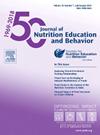Community-Based Participatory Research and Environmental Audits Inform Fruit Intake Intervention in Rural Middle Schools
IF 2.3
3区 医学
Q2 EDUCATION, SCIENTIFIC DISCIPLINES
引用次数: 0
Abstract
Background
Adolescents in rural communities face barriers to adequate fruit intake. Interventions aimed at increasing fruit consumption can be beneficial in middle school populations. Community-Based Participatory Research (CBPR) techniques enhance intervention planning by engaging stakeholders to ensure relevance and feasibility.
Objective
This study aimed to inform the design of an intervention to increase fruit consumption in rural middle schoolers utilizing CBPR techniques and environmental audits.
Study Design, Settings, Participants
Student input was gathered by conducting a CBPR-based activity in three rural middle schools. Students indicated their preferred intervention through an interactive voting activity. Voting options were informed through prior focus groups and included: (1) smoothie bar, (2) fruit taste tests, or (3) fruit-forward murals. Additionally, environmental audits were completed by school nutrition directors to evaluate the impact of cafeteria environments and practices regarding fruit availability and promotion.
Measurable Outcome/Analysis
Student voting data were analyzed for frequency of selection per intervention strategy. Environmental audit data were analyzed on the frequency of fruit availability, promotion strategies, and meal participation efforts.
Results
Students (Nf434) desired a smoothie bar intervention (85%, n=370) over fruit taste tests (10%, n=44) and fruit-forward murals (5%, n=18). Environmental audits (Nf3) revealed all schools (100%, Nf3) offered at least two fruit options daily. Two schools (67%, n=2) used signage to guide meal-building, while only one (33%) had a shared table for unwanted foods (e.g., fruit). Only one school (33%, n=1) conducted taste tests utilizing fruit, and none (0%, n=0) used creative menu naming, especially for fruit offerings.
Conclusions
CBPR methods provided valuable student input on preferred fruit intake interventions, while environmental audits identified key factors influencing fruit accessibility and consumption. These findings will aid in informing the development of an intervention to enhance fruit intake in rural middle schools, thus improving overall adolescent nutrition.
Funding
Wyman's Wild Blueberry Research & Innovation Center Fund
基于社区的参与式研究和环境审计为农村中学水果摄入干预提供信息
农村社区的青少年在摄入足够的水果方面面临障碍。旨在增加水果消费的干预措施可能对中学生有益。基于社区的参与式研究(CBPR)技术通过让利益攸关方参与进来,确保相关性和可行性,从而加强干预规划。目的本研究旨在利用CBPR技术和环境审计为增加农村中学生水果消费的干预设计提供信息。研究设计,设置,参与者通过在三所农村中学开展基于cbpr的活动收集学生的意见。学生透过互动式投票活动,表达他们偏好的干预措施。投票选项是通过事先的焦点小组告知的,包括:(1)冰沙吧,(2)水果味道测试,或(3)水果壁画。此外,学校营养主管还完成了环境审计,以评估自助餐厅环境的影响以及水果供应和推广方面的做法。可测量的结果/分析对学生投票数据进行分析,以确定每种干预策略的选择频率。环境审计数据分析了水果供应的频率、促销策略和用餐参与的努力。结果学生(n f434)希望冰沙吧干预(85%,n=370),而不是水果味道测试(10%,n=44)和水果前壁画(5%,n=18)。环境审计(Nf3)显示,所有学校(100%,Nf3)每天至少提供两种水果选择。两所学校(67%,n=2)使用标识来指导用餐,而只有一所学校(33%)有一个共享桌子来放置不需要的食物(如水果)。只有一所学校(33%,n=1)使用水果进行味道测试,没有一所学校(0%,n=0)使用创造性的菜单命名,特别是水果产品。结论scbpr方法为学生偏好水果摄入干预提供了宝贵的意见,而环境审计则确定了影响水果可及性和消费的关键因素。这些发现将有助于制定干预措施,以增加农村中学的水果摄入量,从而改善青少年的整体营养。资助怀曼野生蓝莓研究;创新中心基金
本文章由计算机程序翻译,如有差异,请以英文原文为准。
求助全文
约1分钟内获得全文
求助全文
来源期刊
CiteScore
4.20
自引率
11.50%
发文量
379
审稿时长
44 days
期刊介绍:
The Journal of Nutrition Education and Behavior (JNEB), the official journal of the Society for Nutrition Education and Behavior, is a refereed, scientific periodical that serves as a global resource for all professionals with an interest in nutrition education; nutrition and physical activity behavior theories and intervention outcomes; complementary and alternative medicine related to nutrition behaviors; food environment; food, nutrition, and physical activity communication strategies including technology; nutrition-related economics; food safety education; and scholarship of learning related to these areas.
The purpose of JNEB is to document and disseminate original research and emerging issues and practices relevant to these areas worldwide. The Journal of Nutrition Education and Behavior welcomes evidence-based manuscripts that provide new insights and useful findings related to nutrition education research, practice and policy. The content areas of JNEB reflect the diverse interests in nutrition and physical activity related to public health, nutritional sciences, education, behavioral economics, family and consumer sciences, and eHealth, including the interests of community-based nutrition-practitioners. As the Society''s official journal, JNEB also includes policy statements, issue perspectives, position papers, and member communications.

 求助内容:
求助内容: 应助结果提醒方式:
应助结果提醒方式:


